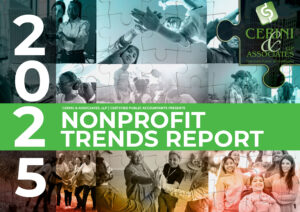In 2025, nonprofit organizations face unique challenges and opportunities in managing their workforce. Here are key trends and strategies to help navigate hiring, compensation, succession planning, and employee retention:
Hiring Trends
Strategic Talent Acquisition:
Recruitment efforts should align with organizational goals and culture to ensure new hires contribute meaningfully to the mission. Identifying candidates with the right skills and attributes that match long-term objectives is critical.
Emphasis on Diversity, Equity, and Inclusion (DEI):
Building diverse and inclusive teams is essential to fostering broader perspectives and better representing the communities served. Organizations implementing DEI initiatives are more likely to attract a wider range of candidates and enhance workplace culture.
Remote Work and Flexibility:
Hybrid and remote work options have become standard expectations. Nonprofits that embrace these models can attract mission-driven professionals who prioritize work-life balance. Flexible arrangements also allow organizations to expand their talent pool, particularly in underserved areas, while boosting employee satisfaction.
Skills-Based Hiring:
Hiring based on transferable skills rather than traditional qualifications can help fill roles with individuals who bring diverse experiences and potential. This approach broadens the pool of qualified candidates.
Technology Adoption:
The use of AI in recruitment is revolutionizing the hiring process. Nonprofits can leverage AI-powered tools to automate resume screening, streamline interview scheduling, and enhance candidate engagement. These technologies save time, reduce costs, and improve efficiency in finding top talent, ensuring resources are directed toward the mission.
Recruitment and Onboarding Best Practices:
Hiring and onboarding practices set the tone for employee relationships. By creating welcoming, inclusive, and enriching experiences, nonprofits can enhance engagement and retention from the start. This includes eliminating bias, aligning recruitment with organizational values, fostering connections through mentorship, and providing relevant training for new hires.
Compensation Trends
Competitive Salaries:
Offering market-aligned salaries for mission-critical roles is essential to attract and retain top professionals. Regularly reviewing compensation to stay competitive can ensure long-term workforce stability.
Comprehensive Benefits:
Total rewards packages, including health insurance, retirement plans, and wellness initiatives, contribute to employee satisfaction and loyalty. Professional development opportunities and work-life balance programs further enhance value.
Performance-Based Incentives:
Variable compensation models tied to organizational objectives can motivate employees and align their efforts with broader goals.
Transparent Practices:
Compensation transparency fosters trust and employee satisfaction. Clear communication about how salaries are determined and ensuring fairness in pay structures are key to maintaining morale.
Succession Planning
Proactive Planning:
With only 27% of nonprofits having documented succession plans, there is a significant opportunity to improve operational stability. Identifying potential leaders and equipping them with training and development ensures smooth transitions when leadership changes occur.
Leadership Development:
Investing in leadership programs prepares internal candidates for advanced roles, promoting continuity and growth within the organization.
Regular Review and Open Dialogue:
Updating succession plans regularly to reflect organizational changes and encouraging open conversations about leadership transitions build stability and resilience.
Employee Retention
Addressing Staffing Challenges:
Adjusting budgets and offering competitive compensation packages, including signing or retention bonuses, can help mitigate staffing shortages. Highlighting benefits and flexible schedules further strengthens retention efforts.
Preventing Burnout:
Supporting work-life balance, mental health resources, and stress management initiatives are vital to maintaining a healthy workforce. Encouraging regular breaks and fostering a supportive environment can help reduce burnout.
Investing in Development:
Providing employees with mentoring, training, and opportunities for career advancement keeps them engaged and motivated. Employees who see a clear path for growth within the organization are more likely to remain committed.
Emerging Workforce Trends
Employee Well-being:
Prioritizing mental health and wellness initiatives, such as offering mental health days and counseling, supports a productive and engaged workforce.
Data-Driven HR Decisions:
Utilizing analytics to identify trends in turnover, engagement, and recruitment allows nonprofits to make informed adjustments and optimize workforce strategies.
Upskilling and Reskilling:
By addressing skill gaps internally through partnerships with educational institutions or online learning platforms, nonprofits can build resilient teams while reducing reliance on external hiring.
Engagement and Recognition:
A culture of recognition that celebrates achievements and aligns work with organizational missions can reignite passion and commitment among employees.
The Strategic Role of HR:
HR leaders in nonprofits are increasingly stepping into strategic roles, championing DEI initiatives, driving innovation, and advocating for employee well-being. Aligning people strategies with organizational goals ensures a sustainable and engaged workforce.
By staying attuned to these trends and implementing strategic workforce practices, nonprofits can attract, develop, and retain top talent, ensuring their mission’s success in 2025 and beyond.

Lauren Grandinetti, CPA
Manager
Lauren has been a member of Cerini & Associates’ audit and consulting practice area since 2012 where she focuses on serving nonprofit, healthcare, employee benefit plan, and education clients. Lauren has experience performing assurance work, outsourced accounting work, and government filings. Lauren brings her expertise, diversified background, and helpful approach to all of her engagements.





No comment yet, add your voice below!